
|
|
|
|
|
|
2040-2045
China's space program is rivalling NASA
During the late 2010s, China revealed a number of long-term plans to significantly expand its national space program. The country was already making progress towards a new space station, but had even greater ambitions for the decades ahead. This roadmap included two new generations of rockets to be introduced in the 2020s and 2030s, followed by a fleet of crewed spacecraft in the 2040s.
The Long March family of rockets had been used since 1970 and made China the fifth nation to achieve independent launch capability. Over the decades, subsequent versions offered more versatility and greater payloads. A new series, the Long March 8, was planned for the early 2020s. It would become the most advanced version yet – allowing China to catch up with NASA in terms of conventional rocket technology and to provide commercial launch services for a number of other countries. In addition, a reusable suborbital carrier was being developed. This space plane, with a scheduled first launch date of 2025, would allow China to begin offering space tourism and a rival to the likes of Virgin Galactic.
During the 2030s, a much more advanced and powerful rocket – Long March 9 (CZ-9) – would be introduced. With a payload of 140 tons to low-Earth orbit (LEO) and more than 50 tons for trans-lunar injection (TLI), this could provide support to crewed lunar landing missions. Its cargo capacity, 18 times more than the earlier Long March 8, would place it within the "super heavy-lift launch vehicle" category along with the Falcon Heavy, the retired Saturn V and Soviet Energia, the Space Launch System and other large rockets under development in the United States. A fully reusable version was planned for 2035. The Long March 9 was to be instrumental in establishing a Chinese presence on the Moon.
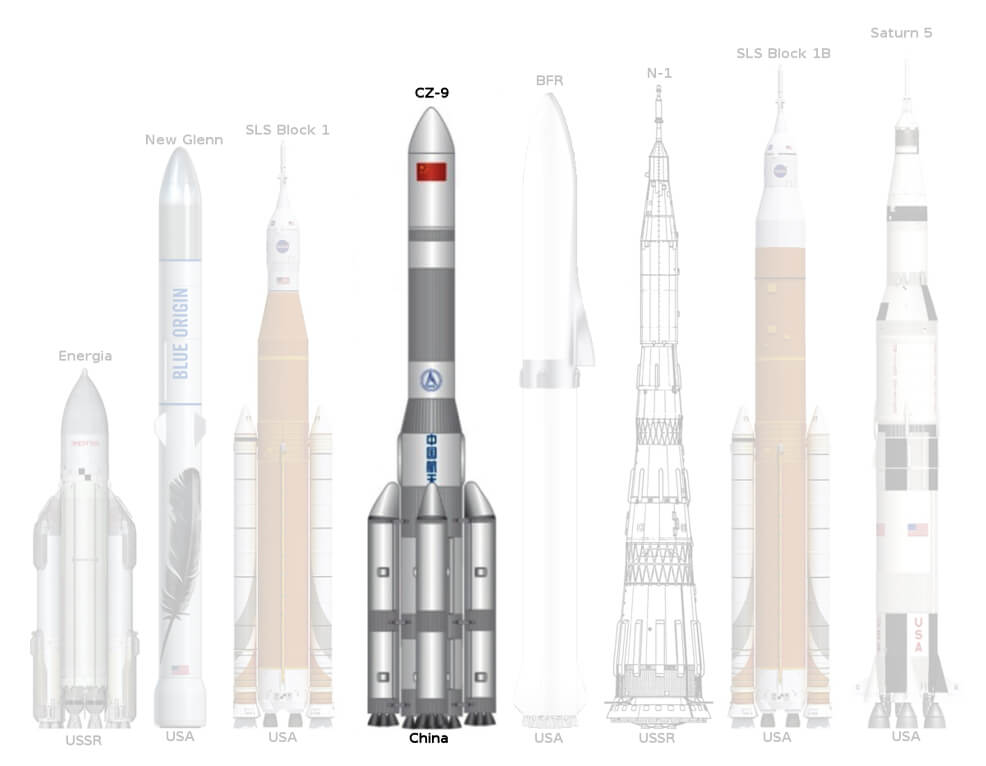
Long March 9 (CZ-9). By Thorenn [CC BY-SA 4.0], from Wikimedia Commons
By 2040-2045, China has further expanded its space program, to such an extent that it now rivals NASA.* The latter had seen its budget decline as a percentage of GDP for several decades. Launch vehicles for multiple, interplanetary round-trips are being introduced with even lower costs. In addition to these large and reusable rockets, a fleet of nuclear-powered space shuttles is becoming operational. These provide crewed, deep space capability for Moon and Mars missions, without the need for solar or chemical propulsion.*
With an expanded budget and improved technology, China has taken the lead in many areas of space. Probes are being launched on a regular basis to explore the Solar System and return samples, while various new telescopes have been deployed. However, entirely new capabilities have also emerged – space resource utilisation through asteroid mining, for example, and the construction of space-based megaprojects, such as orbital solar power stations.
China is also among a group of countries now making the first serious attempts to develop a space elevator, though it will be some time before this is fully built and operational; not just because of technical challenges, but in part due to safety and insurance considerations and the international laws required. Additionally, China's growth rate has begun to cool off, allowing nations like India to gain an increasing share of the space sector. Alongside an explosion of privately-owned and crowd-funded ventures, this is creating a more evenly distributed and multipolar space industry, now worth over a trillion dollars.
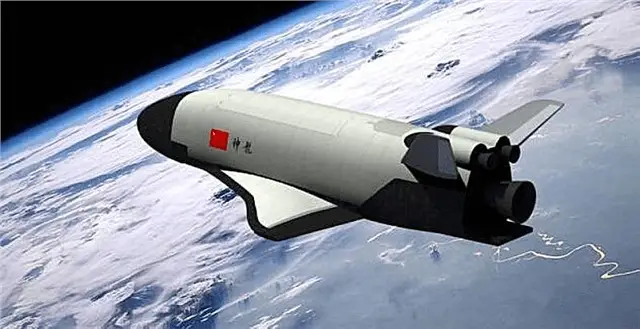
2040
India's economy is rivalling that of China and the U.S.
By 2040, rapid economic growth has enabled India to catch up with China and the U.S. These three countries – the G3 – now have by far the largest share of world GDP.** India has benefitted from a number of cultural, economic and demographic trends in recent decades.* This includes a youthful, growing and economically productive population,* now the world's largest at 1.6 billion,* with an average age of just 34. By comparison, China's average age is 46 and its working population has been declining.*
Expansion and development of India's service sector – adding greatly to the global knowledge-based economy – has occurred in parallel with a slowdown in China's growth rate as its economy matures. India has also managed to avoid many of the disruptive challenges experienced by China, since its market-based economy is already part of a liberal democracy, unlike the planned economy of its rival.
India's currency, the rupee, is now challenging the renminbi as the world's strongest. Due to its global influence and military capabilities, India has also gained a permanent seat on the UN Security Council. Later this decade, on 15th August 2047, the nation will celebrate its 100th anniversary as an independent state.*
However, climate change and other ecological impacts are converging with increasing speed. In particular, neighbouring Bangladesh requires ever more financial support and humanitarian aid, as flooding worsens.* Widespread automation and technological unemployment are also emerging. By the 2050s, India's growth has begun to stagnate, as the world faces a crisis unparalleled in history.**

Fusion power is nearing commercial availability
A prototype commercial fusion reactor is nearing operation.* DEMO (DEMOnstration Power Plant) is the successor to ITER and is designed to build on the success of that project, achieving a number of new breakthroughs. Among the earlier problems being tackled are: containing the plasma at high enough temperatures, maintaining a great enough density of reacting ions, and capturing high-energy neutrons without melting the walls of the interior. Constructed in the 2030s and early 2040s, DEMO is now close to being perfected. Later this decade, it will produce a sustained output of 2 gigawatts (GW), making fusion commercially available for the first time.*

Deep ocean mining operations are widespread
Exploitation of the ocean for its resources had for centuries been confined to fishing and coastal developments. Limits in technology made ventures into deeper waters both impractical and economically unviable. Interest in deep sea mining first appeared in the 1960s, but consistently low prices of mineral resources at the time halted any serious implementation. By the 2000s, the only resource being mined in bulk from the ocean was diamonds, and even then, just a few hundred metres below the surface. Large-scale efforts continued to be hindered in the first decades of the 21st century. By 2040, however, advances in robotics and telepresence have led to a fully mature industry – opening up the vast and previously unobtainable wealth of fuel and mineral reserves along the ocean floor.***
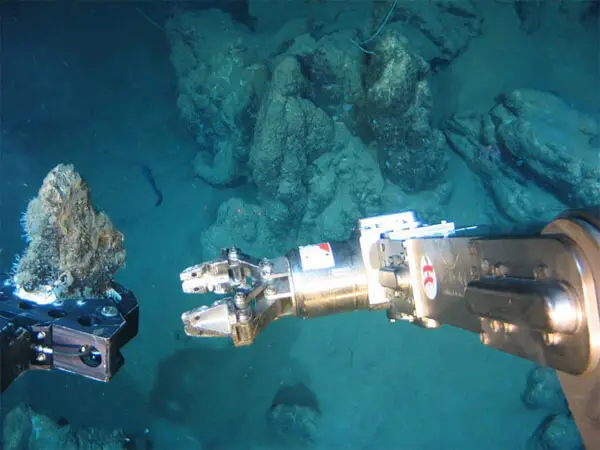
Credit: Nautilus Minerals Inc.
In the past, retrieval operations were limited to manganese nodules (resource-rich rock concretions found on the ocean floor) and metal-rich sediments around hydrothermal vents. Now, thanks to new extraction methods and processing techniques, even the low concentrations of elements found in mud layers are economically viable. Today, prospecting and undersea construction is done using fleets of automated and remote-controlled robots. Once ships or mining platforms are in place, resources are brought to the surface through hydraulic suction or continuous bucket line systems.
The primary focus of these current efforts is rare-earth metals. The rapid growth in demand for these elements, used in a wide range of electronics and other hi-tech applications, has been stymied in recent years by increasingly dire shortages.* This has turned them into resources of strategic importance on the level of oil and natural gas in earlier decades. It has become particularly apparent in Asia, with nations such as India, Japan, South Korea and Indonesia ramping up efforts to free themselves from the near-monopoly that China holds.
Another valuable, though hazardous, target of deep ocean mining is methane hydrate deposits.* This so-called "fire ice" consists of concentrated methane trapped within a crystal of frozen water. It is found throughout the deep ocean in sedimentary structures and outcroppings, with some of the largest known deposits found in the seas of the West Pacific and along the coasts of North America. By itself, methane hydrate far outweighs the total amount of recoverable natural gas. Several nations have established mining operations, with Japan, China, and the United States among the largest producers.*
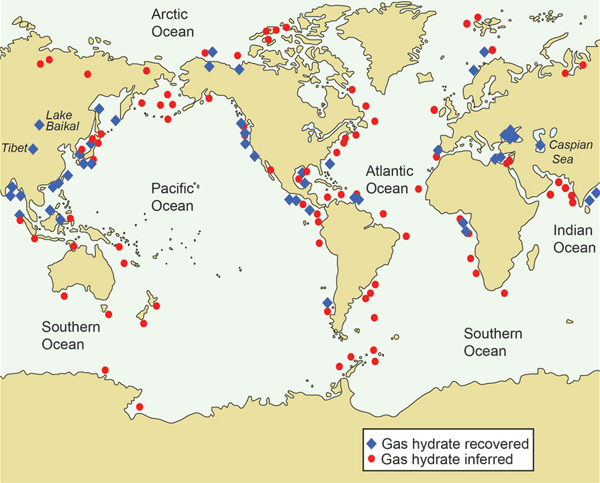
Traditional forms of ocean exploitation still exist. While the number of oil drilling platforms has declined overall, deepwater (500-1500 metres) and ultra-deepwater operations (1500 metres or further) continue to expand as easily-recoverable reserves become scarce.* Following recent spills and ecological disasters, some on the scale of the Deepwater Horizon spill of 2010, such operations remain highly controversial.
In general, most ocean mining and drilling operations are targets of criticism. Concerns over the environmental impact of ocean floor dredging and prospecting have led to stricter regulations in many countries, as well as the development of protected ocean zones. Nevertheless, the impact of deep ocean mining is still considerable in many regions. Even more polarising is methane hydrate drilling, which threatens to further accelerate the pace of global warming.* Despite efforts to eliminate leakage and minimise its impact, methane hydrate mining is still a risky business, with a number of countries flat-out banning it.
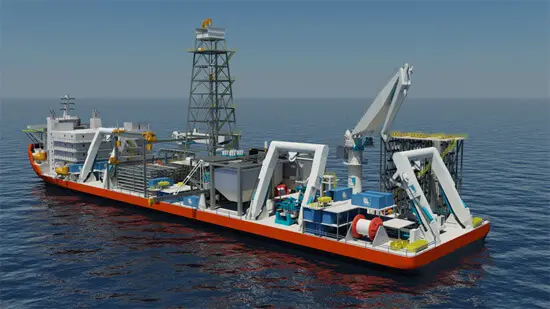
Credit: Nautilus Minerals Inc.
Less than two-thirds of the original Congo jungle remains standing
The Congo region is a sedimentary basin for the drainage of the Congo River in west equatorial Africa. At the turn of the 21st century it contained a quarter of the world's tropical forests, with a total area of 2.5 million sq km.* It held some of the largest undisturbed portions of tropical rainforest on the planet, second only to the Amazon in Brazil. Spanning across six countries, it was home to over 10,000 unique species of tropical plants, 30% of which could not be found anywhere else on Earth. There were over 1,000 bird species, 700 fish species and 400 mammal species. Some noted examples included the Bonobo (humanity's closest living relatives), the Forest Elephant, the okapi, Congo Peafowl, and various species of gorilla. Rare and unique frogs, bats, rodents and birds, together with plants such as orchids, could also be found.
Despite efforts to slow deforestation in the developing countries of Africa, the rainforests of the Congo Basin and elsewhere continued to recede over the decades. As early as the late 2010s, Nigeria's forests had shrunk down to essentially nothing,* while the situation in Central Africa had worsened too. Alongside the bush meat trade impacting fauna, the largely unregulated logging industry continued to chip away at the flora.

Interest in foreign markets led to massive mining operations being conducted in the region, dealing severe damage to its ecosystem. Untapped deposits of raw minerals and metals – estimated to be worth in excess of US$24 trillion* – attracted companies in droves. The expansion of cities and construction of new dams also played a role in harming the fragile environment, while slash-and-burn farming practices began to run rampant as the population soared. Ever-increasing resource demands and the need for economic growth led governments to look the other way during much of this exploitation. This was despite an outcry from the international community and environmentalists.
By 2040, climate change is having an impact too. Since the vast majority of rainfall is generated in the region itself, the resulting isolation makes it more vulnerable to global warming. A large proportion of moisture in Central Africa is produced by evapo-transpiration of trees in the Congo Basin. Substantial reductions in rainfall are now occurring. Loss of forests, especially through fires started by farmers, is pumping huge amounts of CO2 into the atmosphere. The rainforest is now transitioning from a carbon sink to a carbon source. With 66 gigatonnes of "volatile" carbon – and a further 50 gigatonnes in the rest of tropical Africa – the equivalent of five years' worth of global emissions will eventually be released.*
These factors have converged so that, by 2040, less than two-thirds of the original Congo remains. Prior to the arrival of human civilisation, rainforests covered somewhere between 80-85% of the total land area in the region – around 3.29 million square km (1.27 million square miles).** By the mid-20th century, one-fifth had disappeared. Deforestation began to accelerate in the 21st century, due to rapid population growth and economic development. By 2020, the rainforests were declining by 0.3% each year; by 2030 this had risen to 0.5% per year* and by 2040 the rate is 0.7%.
In addition to extinctions of animals and plants, numerous indigenous tribes are being uprooted, their cultures disrupted and in some cases lost forever. There is much social and political upheaval in the region. On top of this, local resource conflicts are beginning to break out, primarily over food. This is only serving to exacerbate the environmental damage. Many areas of forest have become battle grounds, while civilian populations are forced to become more self-sufficient, turning to their surrounding local environment for resources.
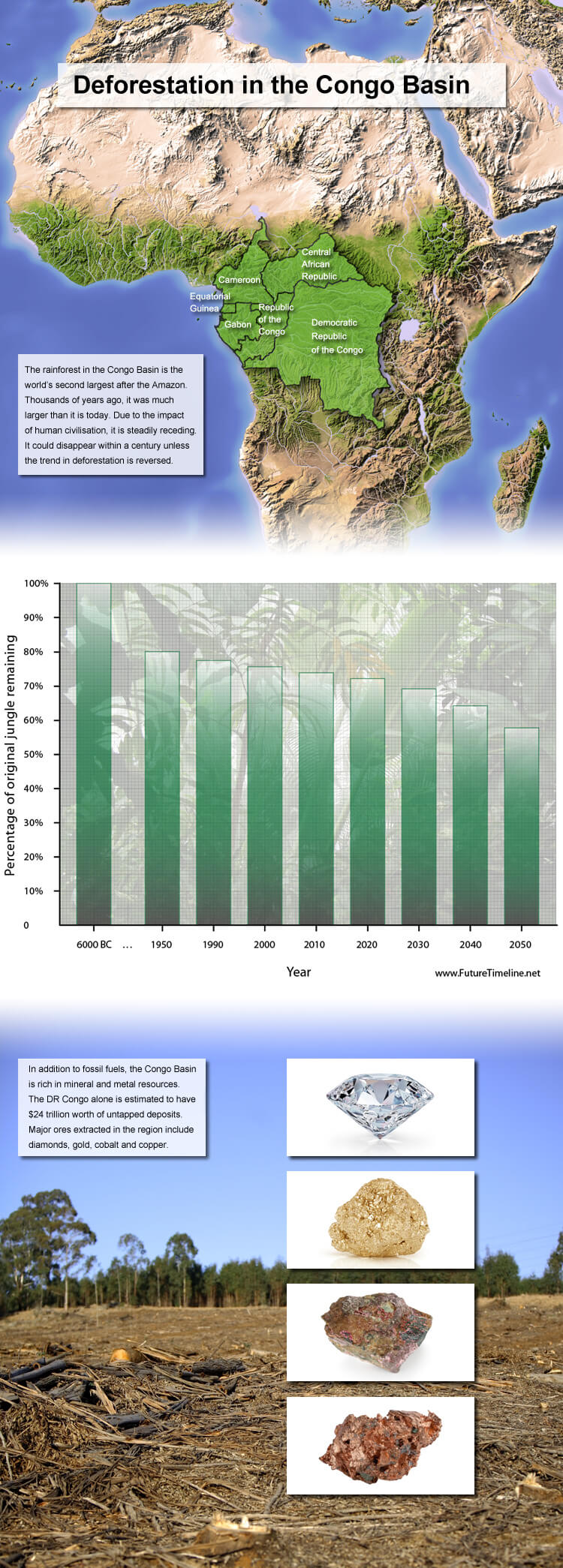
Virtual telepathy is dominating personal communications
First generation brain-computer interfaces reached the consumer market in around 2010. This technology was crude and limited to begin with: more of a novelty than a serious application. Devices could perform only the simplest of operations, such as directional commands.** Some university experiments successfully created text messages using thought power alone,* but were slow and required bulky equipment to do so.
Advances by 2020 enabled the translation of thoughts into intelligible, recognisable speech by combining speech synthesisers and artificial intelligence* – but the process remained slow and inefficient.*
By 2030, however, exponential progress had been made in mapping and understanding the brain and its neuroelectrical signals.* This was filtering down rapidly to the consumer market. Detailed, real-time messages were becoming possible, using non-invasive methods. The graphical interfaces used in composing messages had also been much improved, with more intuitive navigation and features.
By 2040, the technology is largely perfected for everyday use. It works well and is cheap enough to have spread to even developing countries. Privacy and security issues have been resolved, with personal firewalls able to restrict any unwanted intrusion or hacking attempts. The headsets, visors and earphones necessary for users have been miniaturised and made more comfortable. Some are even fully implantable. Whether for business or personal use, people everywhere are now enjoying a faster, more sophisticated, more private way of communicating.
This form of "virtual telepathy" – and the convergence of other network-based technologies – is radically reshaping society and culture during this time. A speculative bubble is formed on the stock markets, with investors everywhere forecasting a revolution in telecoms. This temporarily overheats the economy, resulting in a crash similar to that of the dotcom collapse of early 2000.

Biorepository and genomic information systems are transforming healthcare
By now, most countries have established a national biorepository and genomic information system, with mandatory entry for all citizens. In other words, governments have a genetic sample of every person. This is needed for a variety of reasons – from national security, to public health, citizen ID, immigration control, resolution of crimes and more – but the most common use is in healthcare.
These genomic information systems are integrated with electronic health records and personal health records, allowing identification and treatment of disease and healthcare issues at the earliest opportunity. Hard data from these systems allow doctors and surgeons to better treat their patients, while government and researchers can target time and resources more efficiently. By utilising such a broad spectrum of information, medical schools and healthcare providers can train and employ the best possible mix of specialists for their patient population.
The focus of healthcare has shifted in recent years – to preventative methods, as opposed to reactionary methods after a disease state has occurred. As well as saving more lives, this has major economic benefits too.
By now, the average person is using at least one biotechnological implant.* Once again, these devices are tailored to their exact personal health requirements. For example, they can be programmed to monitor specific conditions and to dispense medication when needed while simultaneously notifying a doctor. They can identify a patient who is unconscious or unable to communicate for whatever reason, providing vital clinical information during an emergency. They can also be used as tracking devices for mental patients or those suffering from neurological conditions.

Pollen counts have more than doubled
In 2000, pollen counts for the US averaged 8,455 per cubic metre of air. By 2040, this figure has risen to 21,735 – largely due to climate change which has caused major alterations in weather, precipitation and temperature.* Alongside this, the hay fever season has shifted to earlier in the year, with pollen counts now peaking on 8th April, compared to 1st May at the start of the century. Similar changes have taken place in countries around the world. Thankfully, new treatments are now available to prevent allergic reactions. Recent years have seen major advances in gene therapy, for instance. These drugs can "repair" the DNA of hay fever sufferers.

Tobacco has been largely eradicated
In the USA, tobacco use peaked in the early 1960s with nearly 45% of adults smoking regularly. As the health risks became more apparent, efforts were made by government, public health advocates, grassroots organisations and others to raise awareness. These campaigns were remarkably successful in stemming the rates of smoking and tobacco-related disease and death. Smoking was banned in aeroplanes, office buildings and later in public locations such as bars and restaurants. Strict laws on the advertising of tobacco products and their use in movies and television were also introduced. In addition, improvements were made in the availability and efficacy of smoking cessation aids and pharmaceuticals.
By the early 90s, the number of US adult smokers had plunged to 25% and by 2010 the figure was down to 20%. By 2020, smoking in public was banned across every US state and in many other countries around the world, with smoking rates continuing to decline.
Efforts continued over the following two decades and once again proved to be highly successful. The costs of government interventions were surprisingly small, less than 50 US cents per person per year in countries such as India and China. By 2040, less than 5% of the global population is smoking.*

Life expectancy for cystic fibrosis reaches 70
Cystic fibrosis (CF) is a genetic disorder that affects most critically the lungs, and also the pancreas, liver, and intestine. It is characterised by abnormal transport of chloride and sodium across an epithelium, leading to thick, viscous secretions.
The name cystic fibrosis refers to the characteristic scarring (fibrosis) and cyst formation within the pancreas. Difficulty breathing is the most serious symptom and results from frequent lung infections that are treated with antibiotics and other medications. Other symptoms, including sinus infections, poor growth, and infertility affect other parts of the body.
When the disease was first described in 1938, survival beyond infancy was rare. In 1952, Paul di Sant' Agnese found abnormalities in sweat electrolytes; a sweat test was developed and improved over the next decade. Despite new treatments – including lung transplants – life expectancy for those affected by the condition remained low throughout the 20th century. By the 1980s, it was still in the twenties.
A major breakthrough was achieved in 1989, however, when the trans-membrane conductance regulator gene was discovered. Subsequent research uncovered thousands of different mutations affecting the gene. As our knowledge of the underlying molecular causes and ways of treating the illness continued to improve, so too did life expectancy. Following several milestones in research, it has reached 70 by 2040.*
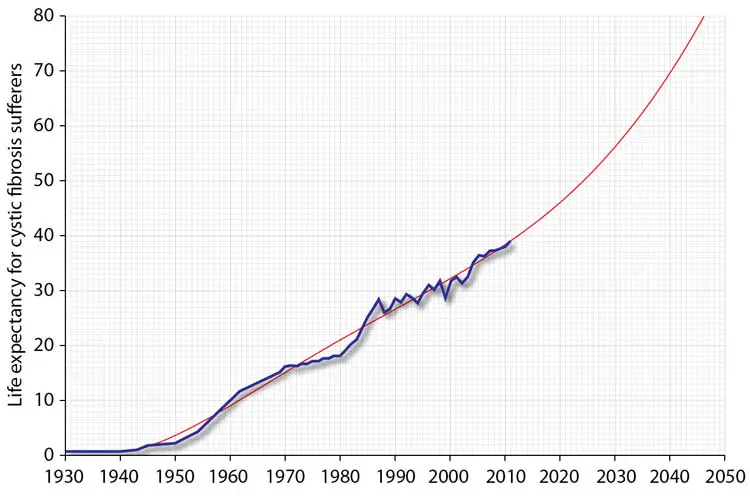
Breakthroughs in carbon nanotube production
After decades of research, new processes have been developed for synthesising carbon nanotubes, promising to revolutionise the fields of engineering, architecture and materials science. Having been limited to a few centimetres, these structures can now reach potentially thousands of miles in length.* Purification techniques ensure maximum tensile strength, making them hundreds of times stronger than steel. Among the many applications, the technology for a space elevator is now available. Political and financial will are the only remaining obstacles for such a project.*

Submarine exploration of Titan
The first probe to Saturn was Pioneer 11 in 1979, which confirmed that its largest moon Titan was probably too cold to support life. This was followed by Voyager 1 and 2, in 1980 and 1981, respectively. Cassini–Huygens was launched in 1997, arriving in 2004, with a lander that returned the first pictures of Titan's surface in 2005.
In subsequent years, a number of conceptual missions were proposed for returning probes to Titan. Of particular interest were the moon's hydrocarbon lakes and oceans, thought to have conditions similar to those on Earth during its early history. Most of NASA's budget and objectives had already been assigned for the next two decades. However, the NASA Institute for Advanced Concepts was established for longer term, visionary goals. Among the projects to emerge from this program was an unmanned submarine intended to explore the subsurface environment of Titan. This began to progress from initial feasibility studies to more detailed and practical designs.
As the years went by, mission capabilities were being enhanced by a new generation of robotics – some aspects of which could be seen in the deep ocean mining operations now appearing on Earth* – while access to space was now a fraction of the cost it had once been. A launch was timed to coincide with Titan's summer during the early 2040s, maximising the period of ice melt and ease of manoeuvrability. The vessel would be delivered to Kraken Mare, a huge lake of methane and ethane approximately 1,000 ft (300 m) deep. This unpiloted submarine features onboard realtime navigation, hazard avoidance systems, an exploration sensor suite, and autonomous science investigation software system. Stunning high quality videos and a plethora of data are returned from this strange alien environment, where temperatures reach below -179°C (-290°F).*
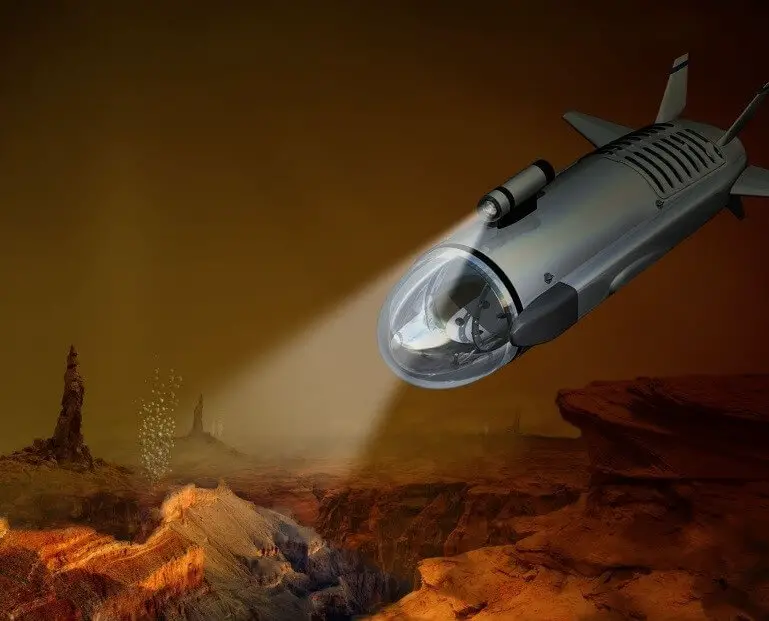
Future Titan mission of the 2040s. Credit: NASA
China's HSR network has been greatly expanded
China's rapid economic growth in the early 21st century was aided by its massive investments in infrastructure. Highways, bridges, tunnels and airports quickly spread throughout the country, linking nearly every major city and regional province, while 15,000 new cars were added to the nation's roads each day. Above all, however, it was high-speed rail that proved to be the driving factor in much of China's rise.**
Similar to the industrial revolution of 200 years previously, rail provided growth and increased prosperity to every area it connected to. Between 2010 and 2020, China invested $300 billion* in constructing over 17,600 km (11,000 mi) of additional rail lines, giving 90% of the population access to the network.* From the 2020s onwards, there was further expansion of high-speed rail, the surge in passenger numbers making HSR a lucrative industry.*
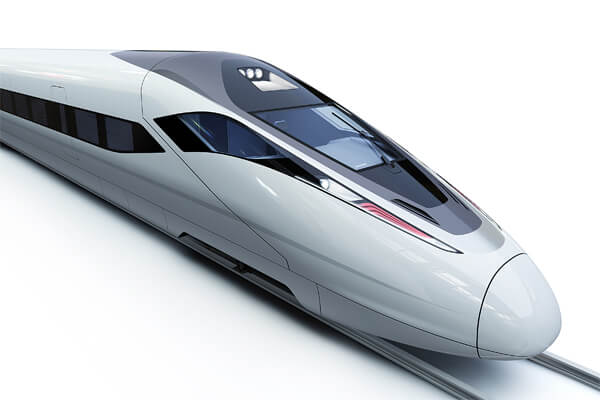
Along with being more energy efficient and cheaper, advances in design and technology boosted train speeds by hundreds of miles per hour, making them competitive with flight schedules in many cases. The very fastest routes now included trains travelling at over 1,000 km/h (625 mph).* Maglev routes were expanded significantly, especially along the coast. Along with internal connections, plans were formulated to link the Chinese rail system with those of Europe, India, Russia and Japan. With such a huge rail network, the cities of China were more closely connected than ever before. In a sense, high-speed rail created a 1.2 billion person "single city" effect, with much of the population only a few hours away from each other.*
Along with growth in commerce, rail has driven – and in turn been driven by – China's unprecedented urbanisation. By 2040, over 70% of the population lives in urban areas.* Vast megacities, each with more than 100 million people, have formed out of the gradual merging of smaller metropolises.* The largest examples today are the three main economic zones: the Yangtze River Delta (Shanghai, Nanjing, and Hangzhou), the Pearl River Delta (Guangzhou, Shenzhen, and Hong Kong) and the Bohai Economic Rim (Beijing, Tianjin, and Tangshan).
Despite all this, China's economy has begun to weaken significantly in recent years.** With a declining workforce and with most of its growth fueled by debt, the country is now embroiled in political, economic and social strife. Restructuring and artificial inflation had managed to sustain the situation temporarily, but could only do so much. Worsening climate change is now an additional factor. This is a particular problem in Shanghai, which has been woefully unprepared for sea level rises.* Though still experiencing moderate local growth, the country as a whole is now approaching crisis point. By the end of this decade, it will have largely stagnated, becoming one of the last major powers to do so.*
Completion of the Northeast Corridor high-speed rail route
By 2040, work is nearing completion on a major upgrade of the Northeast Corridor (NEC). America's busiest rail line, the NEC runs from Boston in the north to Washington in the south, via New York. Like many rail services in the US, it had seen decades of underinvestment. Much of the infrastructure was poorly managed and in need of renovation. Tunnels, for example, had speed restrictions due to their obsolete designs, while electrical components dating from the 1930s would routinely fail. There were engine breakdowns, conflicts among trains and frequent delays costing tens of millions of dollars in lost productivity.
Between 2000 and 2010, intercity ridership on the NEC jumped from 8.2 to 13 million passengers a year. In an effort to address future capacity needs, improve service reliability and reduce travel times, Amtrak formulated plans for a $150 billion, 30-year investment program. This would see construction of a dedicated high-speed route, with trains running up to 220 mph (354 kph).
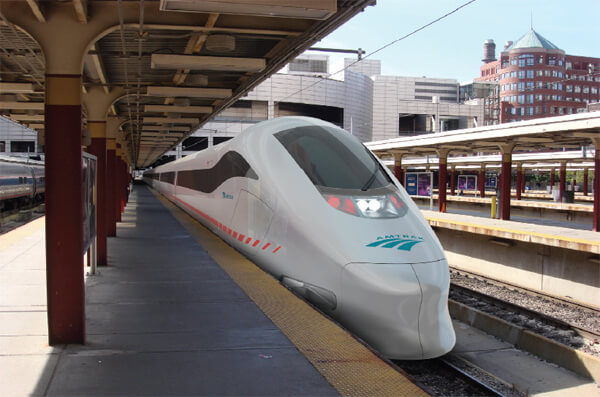
Credit: Amtrak
The plans include fully upgraded tracks and signals, new tunnels, new bridges and expanded stations. Tracks follow the existing NEC and transport networks whenever possible to minimise impacts. Implemented in three main phases, the Newark to New York section is completed by 2025; the Washington to Newark section is completed by 2030 and the final section between New York and Boston is completed by 2040.
Journey times are dramatically reduced. A trip from Boston to New York that previously took 3 hours and 34 minutes can now be completed in just 1 hour and 34 minutes. A trip from New York to Philadelphia is reduced from 1 hour and 10 minutes to just 37 minutes, while a trip from Philadelphia to Washington is cut from 1 hour and 33 minutes to just 54 minutes. For passengers travelling the entire 438 miles (705 km) from Boston to Washington, this means a total reduction in journey time of more than 50% – from 6 hours and 17 minutes, to 3 hours and 5 minutes. Following many years of neglect, this region of the United States finally has a world class rail system.*

Credit: Amtrak
Completion of the Helsinki–Tallinn Tunnel
The Helsinki–Tallinn Tunnel is an undersea tunnel that spans the Gulf of Finland and connects the Finnish and Estonian capitals by train. With a submarine length of more than 50 km (30 mi), it becomes the longest undersea tunnel in the world, exceeding the 37.9 km (23.5 mi) Channel Tunnel between England and France.
The need for such a tunnel arose due to a bottleneck in the movement of people and cargo across the Gulf. Ferry journeys took two hours, with growing millions of people requiring transport. Helsinki already held the title of busiest passenger harbour in the world. Meanwhile, overland travel between Helsinki and Tallinn involved an 800 km (500 mi) journey to the east and through Russia.
Plans for a crossing first emerged in the late 2000s. The governments of both countries applied to the EU for funding and survey reports. Alongside this, entrepreneurs and private interests began producing their own tunnel and station designs. Following technical assessments, studies of long-term passenger and freight volumes, and a cost-benefit analysis, Estonia and Finland signed a Memorandum of Understanding in 2021. This would foster mutual cooperation in the transport sector, including large-scale developments like the Helsinki-Tallinn tunnel.
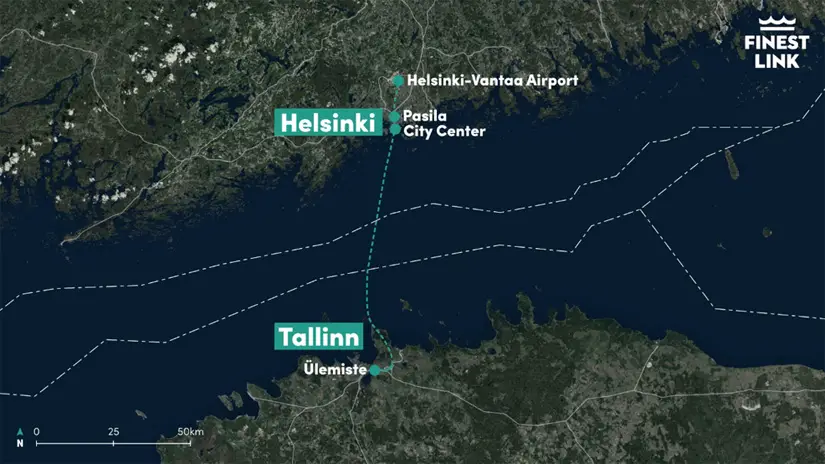
A feasibility study had forecast passenger numbers between Helsinki and Tallinn to increase from eight million (2013) to 41 million by 2080. This growth in demand and the predicted economic benefits ensured that the project received approval.
Beginning in the mid-2020s, the 15-year construction process would include artificial islands, built from excavation waste. At its deepest point, the tunnel reaches 250 m (820 ft) below the sea surface. It consists of two running tubes, with a smaller third tube for maintenance. These are connected by emergency escape passages at intervals along the route.
With Helsinki and Tallinn forming an economic region of 1.5 million inhabitants, the tunnel helps to create what is effectively a metropolitan twin-city region where people, goods and services can move around easily. Passenger trains capable of 200 km/h (125 mph) slash travel times between Helsinki and the city of Tallinn from two hours to just 30 minutes. The tunnel also includes car and truck shuttle trains at 160 km/h (100 mph), as well as freight at 120 km/h (75 mph).
At €16bn, the Helsinki–Tallinn Tunnel is costlier than the Brenner Base Tunnel (€10.4bn), Mont d'Ambin Base Tunnel (€10bn), and Gotthard Base Tunnel (€10bn), and is comparable to the Channel Tunnel (€16.3bn). However, when measured on a cost per kilometre basis, it is less expensive than all four except for the Gotthard Base Tunnel, thanks to favourable geological conditions. Overall, this new rail route generates up to €6.9bn in economic benefits in the first 30 years of its operation.
Upon completion in 2040, the Helsinki–Tallinn Tunnel is linked at its southern end to Rail Baltica, a new electric rail network that passes down through Latvia, Lithuania, and Poland. Rail Baltica itself is connected to Berlin, which leads to many other cities further West. Combined with various other projects, the continent of Europe is now extremely well connected in terms of rail travel and freight transport.
All civil domestic aviation in Norway is electric
In the late 2010s, Norway's state-owned airport operator Avinor proposed an upgrade of the country's short-haul airline fleet – intended to transition it from traditional jet fuel to electric planes. This idea received further attention in 2020, when Avinor and the Civil Aviation Authority released a report exploring these long-term plans in more detail.
Norway already had more than 200 research and development projects underway for electric or hybrid-electric passenger aircraft, with a particular focus on smaller planes of less than 20 seat capacity. The aviation authorities, collaborating alongside domestic airlines, used their knowledge and experience of the region to develop zero-emission aircraft suited to Norwegian winter conditions and runway lengths on the short-haul network.
Advances in battery technology offered the potential to fly aircraft longer distances on a single charge. This included a new generation of solid-state batteries with 650Wh/kg of energy density, compared to 250Wh/kg for conventional lithium-ion cells.* These devices, embedded in the fuselage and wings, led to a first fully electric domestic flight by 2030.

Credit: Eviation
Further progress in the 2030s resulted in additional range extensions, opening up new routes. By 2040, these are sufficient to cover Norway's entire short-haul domestic network and form connections to neighbouring Scandinavian cities.*
Prior to this transition, air travel on domestic routes accounted for 2.4% of Norwegian greenhouse gas emissions. Other benefits of these new planes include a halving in the level of noise pollution, along with lower operational and maintenance costs.
Norway serves as a model for other countries and airlines. In subsequent decades, even greater energy densities become possible, enabling larger aircraft with higher seating capacities and longer routes to incorporate purely electric systems.
A pan-European hydrogen network has emerged
By 2040, much of western Europe has established a "backbone" for the transport of hydrogen, now a mature industry.* This consists of a pipeline network with a total length of almost 23,000 km and supplying up to 1,130 TWh of annual hydrogen demand. It runs through nearly a dozen countries and forms a major part of decarbonisation efforts across the continent.
The cost of building this network – with an upper estimate of €64 billion – is relatively low. About 75% of the planned infrastructure already exists in the form of redundant natural gas pipelines, more and more of which have been retrofitted, as fossil fuel volumes continue to decline. The amount of electricity required for transporting hydrogen over a distance of 1,000 km is only 2% of the energy content of the transported hydrogen, making it highly efficient and cost-effective.
The emergence of this large-scale infrastructure has made it easier to scale up both the production and use of hydrogen. Although outnumbered by the battery electric sector, the market for hydrogen-powered vehicles has grown substantially. This includes ground vehicles such as buses, cars, trains, and trucks, but also now a significant percentage of aircraft* and ships.**
Meanwhile, industrial processes that once relied heavily on fossil fuels – such as steelmaking and rolling,* chemical production and so on – are making a rapid transition to clean technology, including hydrogen. The heating of homes, workplaces, and other buildings is also increasingly done with hydrogen. Furthermore, hydrogen can be used to store energy from renewable resources, such as wind and solar, to help balance daily and seasonal fluctuations in supply and demand.
A group of European gas companies first presented their proposal for the hydrogen backbone in 2020.* Development began in the mid-2020s, with an early pipeline network of 6,800 km connecting local clusters (so-called "hydrogen valleys") by 2030. The next stage involved consumers in the centre of the continent being connected to regions with abundant green hydrogen resource potential, including from Danish offshore wind resources, as well as solar and wind resources from the south of France. By 2040, the backbone has further expanded, to become a truly pan-European hydrogen network allowing connections with global import routes, such as from North Africa and the Middle East.*
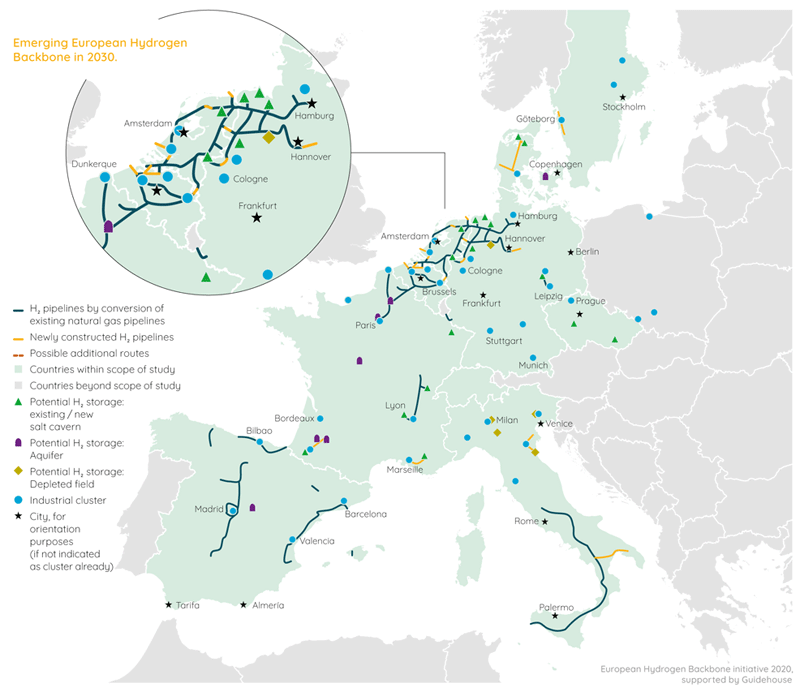
Kidney cancer mortality falls below 1 per 100,000
Kidney cancer is a type of malignancy that originates in renal tissue, most often in the lining of tiny tubes within the kidney known as renal tubules. It accounts for a relatively small proportion of all cancer cases, but its potential to grow silently and spread quickly made it a serious health concern throughout much of the 20th and early 21st centuries. Researchers identified several risk factors, including smoking, obesity, high blood pressure, genetic predisposition, and certain occupational exposures. The disease affected men more frequently than women, and doctors often detected it only after it had reached an advanced stage.
During the late 20th century, countries in Europe, North America, and parts of Asia witnessed a steady rise in kidney cancer diagnoses, partly due to improved imaging and recordkeeping, but also linked to lifestyle and environmental factors. Mortality rates reached a peak of nearly 2.4 per 100,000 in the mid-1990s, before stabilising and beginning a gradual decline in the early 21st century.* This turnaround reflected early progress in medical imaging, surgical precision, and targeted therapies, though challenges remained in access, treatment variability, and the management of rare subtypes.
This downward trend in mortality continued in the 2020s and 2030s, supported by further advances in diagnostics and treatments. By 2040, the figure has fallen below 1 per 100,000 for the first time – a major milestone in the fight against this disease. In public health terms, an age-standardised mortality rate of less than 1 per 100,000 is sometimes regarded as a threshold for near-elimination. While kidney cancer continues to exist and still presents challenges in certain subtypes, the achievement of this benchmark reflects its growing rarity in the most advanced regions, both in incidence and fatality.

Early detection has played a key role. Advances in imaging technology – particularly the integration of AI into diagnostic workflows – have made it easier to identify kidney tumours during scans for unrelated conditions. Faster scanning systems, reduced radiation exposure, and algorithm-based triage now help radiologists detect abnormalities sooner, often before symptoms appear. In high-risk patients, more proactive screening protocols have emerged, contributing to earlier diagnoses and improved outcomes.
Targeted therapies have advanced considerably by 2040. Earlier drugs that blocked angiogenesis have been replaced by multi-modal treatments tailored to a tumour's molecular signature. AI models trained on millions of biopsy results help guide clinicians toward optimal drug combinations, reducing time-to-treatment and minimising trial-and-error approaches. Immunotherapy has also become a standard option for more advanced cases. This includes checkpoint inhibitors that help the immune system recognise cancer cells, as well as emerging CAR-T variants that reprogram a patient's own immune cells to target and destroy tumours – an approach now beginning to show promise in treating solid cancers like kidney cancer.
Surgery is also evolving. Robotic systems equipped with tactile feedback and precision microtools make nephron-sparing procedures safer and more efficient.* Nephron-sparing surgery (partial nephrectomy) removes only the tumour-bearing part of the kidney and preserves healthy tissue to maintain renal function. Developed regions have seen robot-assisted partial nephrectomy (RAPN) become increasingly prevalent – even for complex or central tumours – resulting in excellent outcomes while minimising complications and speeding recovery. Most patients with early-stage kidney cancer now recover quickly from minimally invasive interventions, with post-operative AI monitoring ensuring any signs of recurrence are caught early.
Although some rare or aggressive subtypes still exist, the vast majority of kidney cancers in the developed world are now treatable or curable, with survival rates approaching 100% for localised cases detected early and confined to the kidney. As a result, kidney cancer has become one of the first major solid tumours to reach the benchmark of near-elimination in terms of population-level mortality.
« 2039 |
⇡ Back to top ⇡ |
2041 » |
If you enjoy our content, please consider sharing it:
References
1 China aims to be world-leading space power by 2045,
China Daily:
http://www.chinadaily.com.cn/china/2017-11/17/content_34653486.htm
Accessed 29th April 2018.
2 China sets out long-term space transportation roadmap including a nuclear space shuttle,
gbtimes:
https://gbtimes.com/china-sets-out-long-term-space-transportation-roadmap-including-a-nuclear-space-shuttle
Accessed 29th April 2018.
3 Strategic Trends Programme: Regional Survey – South Asia out to 2040,
Ministry of Defence:
https://www.gov.uk/government/uploads/system/uploads/attachment_data/file/49954/20121129_dcdc_gst_regions_sasia.pdf
Accessed 6th June 2013.
4 GDP projections from PwC: how China, India and Brazil will overtake the West by 2050,
The Guardian:
http://www.guardian.co.uk/news/datablog/2011/jan/07/gdp-projections-china-us-uk-brazil
Accessed 6th June 2013.
5 India aims to end poverty by 2040,
BBC:
http://news.bbc.co.uk/1/hi/world/south_asia/6326629.stm
Accessed 6th June 2013.
6 India's demographic dividend,
BBC:
http://news.bbc.co.uk/1/hi/6911544.stm
Accessed 6th June 2013.
7 See 2027.
8 Unravelling India, Part 3: Demography,
Breaking Views:
http://www.breakingviews.com/unravelling-india-part-3-demography/20044644.article
Accessed 6th June 2013.
9 Independence Day (India),
Wikipedia:
http://en.wikipedia.org/wiki/Independence_Day_%28India%29
Accessed 6th June 2013.
10 Warming Climate to Hit Bangladesh Hard with Sea Level Rise, More Floods and Cyclones, World Bank Report Says,
World Bank:
http://www.worldbank.org/en/news/press-release/2013/06/19/warming-climate-to-hit-bangladesh-hard
Accessed 26th May 2018.
11 See 2050.
12 See 2060-2100.
13 "After ITER success around 2030, we can start the DEMO national projects. DEMO could produce energy by 2040 and feed fusion power to the grid."
A "true engagement" to bring about a sustainable future,
ITER:
https://www.iter.org/fr/newsline/286/1742
Accessed 21st February 2018.
14 DEMOnstration Power Station, Wikipedia:
https://en.wikipedia.org/wiki/DEMOnstration_Power_Station
Accessed 21st February 2018.
15 "India and China have both begun offshore exploration for REMs. Production from deep-sea mining is still years away, some estimates say 2030-2040, if it is viable at all."
The Next Oil?: Rare Earth Metals, The Diplomat:
http://thediplomat.com/2013/01/the-new-prize-china-and-indias-rare-earth-scramble/
Accessed 23rd December 2013.
16 "Experts do not discount the notion that we may someday mine rare-earth metals in the deep sea; perhaps the buzzwords of the year 2040 will be 'Autonomous Underwater Mining Vehicle.' But if you're wondering where rare-earth components in computer chips and solar cells will come from for the next decade, the answer is clear—China."
Why Deep-Sea Rare-Earth Metals Will Stay Right Where They Are—For Now, Popular Mechanics:
http://www.popularmechanics.com/science/environment/why-deep-sea-rare-earth-metals-will-stay-right-where-they-are-for-now
Accessed 23rd December 2013.
17 Analyzing the promise of Deep Sea Mining, The Massachusetts Institute of Technology:
http://web.mit.edu/12.000/www/m2016/finalwebsite/solutions/oceans.html
Accessed 23rd December 2013.
18 "The world is set to consume three times more natural resources than current rates by the middle of the century, according to a United Nations report."
Rising resource use threatens future growth, warns UN, BBC News:
http://www.bbc.co.uk/news/science-environment-13376416
Accessed 23rd December 2013.
19 "Not everyone believes in that timeline. 'They have the gas, but there's no infrastructure yet,' says Basel Asmar, an oil and gas analyst with IHS, an energy consultancy based in Englewood, Colorado. 'There are no pipelines in that area of the ocean.' He thinks that it will be at least two decades until methane hydrates make an impact."
The ice gas cometh, The Sydney Morning Herald:
http://www.smh.com.au/environment/energy-smart/the-ice-gas-cometh-20130928-2ulaj.html
Accessed 23rd December 2013.
20 Mining "Ice That Burns", Technology Review:
http://www.technologyreview.com/news/413730/mining-ice-that-burns/
Accessed 23rd December 2013.
21 The Future of the Ocean Economy, OECD:
http://www.oecd.org/futures/The%20Future%20of%20the%20Ocean%20Economy%20Project%20Proposal%20Sept%202013.pdf
Accessed 23rd December 2013.
22 'Fire Ice': Buried Under The Sea Floor, This New Fossil Fuel Source Could Be Disastrous For The Planet, Climate Progress:
http://thinkprogress.org/climate/2013/07/29/2370661/methane-hydrates-potentially-massive-greenhouse-gas-on-the-sea-floor-faces-earthquakes-and-drilling/
Accessed 23rd December 2013.
23 Global Forest Resources Assessment 2010, The UN Food and Agriculture Organization:
http://www.fao.org/forestry/fra/fra2010/en/
Accessed 19th February 2012.
24 See 2018.
25 Congo with $24 Trillion in Mineral Wealth BUT still Poor, News About Congo:
http://www.newsaboutcongo.com/2009/03/congo-with-24-trillion-in-mineral-wealth-but-still-poor.html
Accessed 19th February 2012.
26 Protecting and restoring forest carbon in tropical Africa, Forest Philanthropy Action Network:
http://files.forestsnetwork.org/Chapter3.pdf
Accessed 19th February 2012.
27 Forests, Grasslands, and Drylands-- Dem. Rep. of the Congo, World Resources Institute:
http://www.wri.org/sites/default/files/uploads/for_cou_180.pdf
Accessed 3rd January 2018.
28 Original and remaining forest cover, The UNEP World Conservation Monitoring Centre:
http://www.unep-wcmc.org/medialibrary/2011/09/27/cc69b7bf/currorig.jpg
Accessed 19th February 2012.
29 Model predicts future deforestation, Nature:
http://www.nature.com/news/2009/091120/full/news.2009.1100.html
Accessed 19th February 2012.
30 See 2009.
31 Gaming
gadgets 'rock' at CES 2009, BBC:
http://news.bbc.co.uk/1/hi/technology/7822293.stm
Accessed 5th June 2010.
32 Twitter
Telepathy: Researchers Turn Thoughts Into Tweets, Wired:
http://www.wired.com/wiredscience/2009/04/braintweet/
Accessed 5th June 2010.
33 Brain signals converted directly into speech, Future Timeline Blog:
https://www.futuretimeline.net/blog/2019/01/30.htm
Accessed 5th January 2020.
34 The
futurist, Ray
Kurzweil, splits the emergence of new technologies into four distinct
stages:
Stage 1: The technology is extremely expensive, doesn't work well, and
is rare.
Stage 2: The technology is expensive, works better, and is more widely
available.
Stage 3: The technology is cheap, works well, and is becoming widespread.
Stage 4: The technology is very cheap or even free, is perfected, and
found everywhere.
35 The Singularity is Near, by Ray Kurzweil (2005)
http://www.amazon.com/Singularity-Near-Humans-Transcend-Biology/dp/0143037889/ref=sr_1_1?ie=UTF8&s=books&qid=1261913594&sr=1-1
Accessed 5th June 2010.
36 European
Journal of ePractice, No.8 – December 2009, epractice.eu:
http://www.epractice.eu/files/European%20Journal%20epractice%20Volume%208_FULL.pdf
Accessed 13th August 2010.
37 The Year 2040: Double the Pollen, Double the Allergy Suffering?, ScienceDaily:
http://www.sciencedaily.com/releases/2012/11/121109083736.htm
Accessed 11th November 2012.
38 World's
leading scientists join forces to set priority interventions to save 36
million lives from non-communicable diseases, EurekAlert!:
http://www.eurekalert.org/pub_releases/2011-04/l-wls040111.php
Accessed 7th June 2011.
39 Data sources for graph:
Cystic Fibrosis in the 21st Century, CML Cystic Fibrosis:
http://www.remedicajournals.com/CML-Cystic-Fibrosis/BrowseIssues/Volume-1-Issue-1/Article-Cystic-Fibrosis-in-the-21st-Century
Is Cystic Fibrosis Lung Disease Caused by Abnormal Ion Composition or Abnormal Volume?, National Center for Biotechnology Information:
http://www.ncbi.nlm.nih.gov/pmc/articles/PMC2233826/
Cystic Fibrosis: Life Expectancy, National Jewish Health:
http://www.nationaljewish.org/healthinfo/conditions/cysticfibrosis/life-expectancy/
Article from 2011: "The median life expectancy of a person with CF is now 39 years old."
See Torrington family bands together to find cure for CF, American-Republican Inc.:
http://www.rep-am.com/articles/2011/11/05/sports/high_school/596862.txt
Accessed 31st October 2013.
40 Physics
of the Impossible, by Michio Kaku:
http://www.amazon.com/Physics-Impossible-Scientific-Exploration-Teleportation/dp/0307278824/ref=sr_1_1?ie=UTF8&s=books&qid=1250029787&sr=1-1
Accessed 26th November 2009.
41 Space
elevator, Wikipedia:
http://en.wikipedia.org/wiki/Space_elevator
Accessed 26th November 2009.
42 See 2040.
43 A Submarine for Saturn's Moon Titan? NASA Backs Way-Out Ideas, NBC News:
http://www.nbcnews.com/science/space/submarine-saturns-moon-titan-nasa-backs-way-out-ideas-n124166
Accessed 2nd October 2014.
44 China's building a high speed rail economy and could achieve a 1 to 1.2 billion person single city effect by 2040, Next Big Future:
http://nextbigfuture.com/2010/09/chinas-building-high-speed-rail-economy.html
Accessed 5th September 2012.
45 China says to support railway investment -Xinhua, Reuters:
http://www.reuters.com/article/2012/06/08/china-railways-idUSL4E8H87KK20120608
Accessed 5th September 2012.
46 China Buys 80 Very High Speed Trains (236 mph) for $4 Billion, Tree Hugger:
http://www.treehugger.com/cars/china-buys-80-very-high-speed-trains-236-mph-for-4-billion.html
Accessed 5th September 2012.
47 Can High-Speed Rail Reduce Our Reliance on Air Travel?, Fast Company:
http://www.fastcompany.com/1546201/can-high-speed-rail-reduce-our-reliance-air-travel
Accessed 5th September 2012.
48 High Speed Rail reports first ever profit, The China Post:
http://www.chinapost.com.tw/taiwan/business/2012/06/23/345291/High-Speed.htm
Accessed 5th September 2012.
49 1,000 KPH (620 MPH) Super Train for China, Clean Technica:
http://cleantechnica.com/2010/08/19/1000-kph-620-mph-super-train-for-china/
Accessed 5th September 2012.
50 China's building a high speed rail economy and could achieve a 1 to 1.2 billion person single city effect by 2040, Next Big Future:
http://nextbigfuture.com/2010/09/chinas-building-high-speed-rail-economy.html
Accessed 5th September 2012.
51 Over half of China's people now live in urban areas, The Economist:
http://www.economist.com/blogs/graphicdetail/2012/01/daily-chart-6
Accessed 5th September 2012.
52 UN report: World's biggest cities merging into 'mega-regions', The Guardian:
http://www.guardian.co.uk/world/2010/mar/22/un-cities-mega-regions
Accessed 5th September 2012.
53 How Will China Pay Off Its Debt?, Forbes:
http://www.forbes.com/sites/gordonchang/2012/02/26/how-will-china-pay-off-its-debt/
Accessed 5th September 2012.
54 China's predicament, The Economist:
http://www.economist.com/node/13888069?story_id=13888069
Accessed 5th September 2012.
55 Flood risk ranking reveals vulnerable cities, Future Timeline Blog:
https://www.futuretimeline.net/blog/2012/08/22-3.htm
Accessed 5th September 2012.
56 See 2050.
57 The Amtrak Vision for the Northeast Corridor – 2012 Update Report, Amtrak:
http://www.amtrak.com/ccurl/453/325/Amtrak-Vision-for-the-Northeast-Corridor.pdf
Accessed 8th July 2012.
58 Norwegian authorities aim for electric aircraft debut by 2030, Flight Global:
https://www.flightglobal.com/air-transport/norwegian-authorities-aim-for-electric-aircraft-debut-by-2030/137146.article
Accessed 14th April 2020.
59 Norway pushes to electrify all domestic flights by 2040, The Next Web:
https://thenextweb.com/shift/2020/03/09/norway-pushes-to-electrify-all-domestic-flights-by-2040/
Accessed 14th April 2020.
60 Gas grid operators unveil plan for European hydrogen infrastructure 'backbone', EURACTIV:
https://www.euractiv.com/section/energy/news/gas-grid-operators-unveil-plan-for-european-hydrogen-infrastructure-backbone/
Accessed 4th February 2021.
61 Airbus reveals new zero-emission concept aircraft, Airbus:
https://www.airbus.com/newsroom/press-releases/en/2020/09/airbus-reveals-new-zeroemission-concept-aircraft.html
Accessed 4th February 2021.
62 World's largest container shipping group pledges to go carbon neutral by 2050, Future Timeline Blog:
https://www.futuretimeline.net/blog/2018/12/6.htm
Accessed 4th February 2021.
63 This hydrogen-powered dreamboat is here to clean up the seven seas, Wired:
https://www.wired.co.uk/article/hydrogen-ships-eu
Accessed 4th February 2021.
64 Using hydrogen to heat steel, Future Timeline Blog:
https://www.futuretimeline.net/blog/2020/06/1-hydrogen-heat-steel-rolling.htm
Accessed 4th February 2021.
65 The European Hydrogen Backbone vision, Gas for Climate:
https://gasforclimate2050.eu/ehb/
Accessed 4th February 2021.
66 European Hydrogen Backbone, Enagás, Energinet, Fluxys Belgium, Gasunie, GRTgaz, NET4GAS, OGE, ONTRAS, Snam, Swedegas, Teréga:
https://gasforclimate2050.eu/?smd_process_download=1&download_id=471
Accessed 4th February 2021.
67 Age-standardized rate (World) per 100 000, mortality, both sexes, Australia + Austria + Canada + France (metropolitan) + Greece + Hungary + Ireland + Italy + Japan + The Netherlands + Singapore + Spain + Switzerland, United Kingdom, USA – Kidney, Cancer Over Time:
https://gco.iarc.fr/overtime/en/dataviz/trends...
Accessed 27th July 2025.
68 A systematic review of robot-assisted partial nephrectomy outcomes for advanced indications: Large tumors (cT2-T3), solitary kidney, completely endophytic, hilar, recurrent, and multiple renal tumors, Asian Journal of Urology:
https://pmc.ncbi.nlm.nih.gov/articles/PMC10659988/
Accessed 27th July 2025.
![[+]](https://www.futuretimeline.net/images/buttons/expand-symbol.gif)






